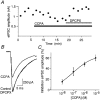Inhibition by adenosine receptor agonists of synaptic transmission in rat periaqueductal grey neurons
- PMID: 10066936
- PMCID: PMC2269220
- DOI: 10.1111/j.1469-7793.1999.219aa.x
Inhibition by adenosine receptor agonists of synaptic transmission in rat periaqueductal grey neurons
Abstract
1. The actions of selective adenosine A1 and A2 receptor agonists were examined on synaptic currents in periaqueductal grey (PAG) neurons using patch-clamp recordings in brain slices. 2. The A1 receptor agonist 2-chloro-N-cyclopentyladenosine (CCPA), but not the A2 agonist, 2-p-(2-carboxyethyl)phenethylamino-5'-N-ethylcarboxamidoadenosine (CGS21680), inhibited both electrically evoked inhibitory (eIPSCs) and excitatory (eEPSCs) postsynaptic currents. The actions of CCPA were reversed by the A1 receptor antagonist 8-cyclopentyl-1, 3-dipropylxanthine (DPCPX). 3. In the absence or presence of forskolin, DPCPX had no effect on eIPSCs, suggesting that concentrations of tonically released adenosine are not sufficient to inhibit synaptic transmission in the PAG. 4. CCPA decreased the frequency of spontaneous miniature action potential-independent IPSCs (mIPSCs) but had no effect on their amplitude distributions. Inhibition persisted in nominally Ca2+-free, high Mg2+ solutions and in 4-aminopyridine. 5. The CCPA-induced decrease in mIPSC frequency was partially blocked by the non-selective protein kinase inhibitor staurosporine, the specific protein kinase A inhibitor 8-para-chlorophenylthioadenosine-3',5'-cyclic monophosphorothioate (Rp-8-CPT-cAMPS), and by 8-bromoadenosine cyclic 3',5' monophosphate (8-Br-cAMP). 6. These results suggest that A1 adenosine receptor agonists inhibit both GABAergic and glutamatergic synaptic transmission in the PAG. Inhibition of GABAergic transmission is mediated by presynaptic mechanisms that partly involve protein kinase A.
Figures




References
-
- Bandler R, Shipley MT. Columnar organization in the midbrain periaqueductal gray: modules for emotional expression? Trends in Neurosciences. 1994;17:379–389. - PubMed
-
- Barraco RA, Phillis JW, Campbell WR, Marcantonio DR, Salah RS. The effects of central injections of adenosine analogs on blood pressure and heart rate in the rat. Neuropharmacology. 1986;25:675–680. - PubMed
-
- Bonci A, Williams JT. A common mechanism mediates long-term changes in synaptic transmission after chronic cocaine and morphine. Neuron. 1996;16:631–639. - PubMed
-
- Chen G, van den Pol AN. Adenosine modulation of calcium currents and presynaptic inhibition of GABA release in suprachiasmatic and arcuate nucleus neurons. Journal of Neurophysiology. 1997;77:3035–3047. - PubMed
Publication types
MeSH terms
Substances
LinkOut - more resources
Full Text Sources
Miscellaneous

